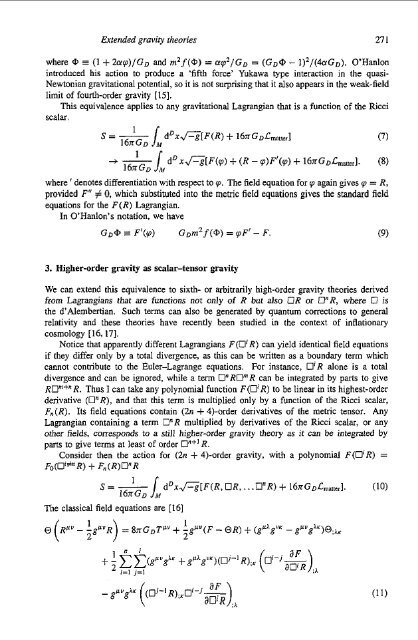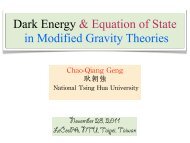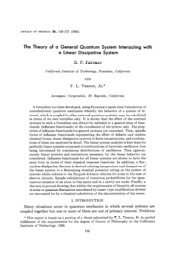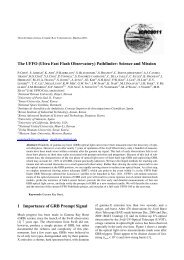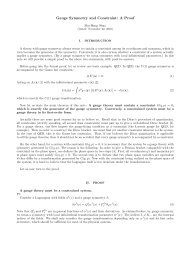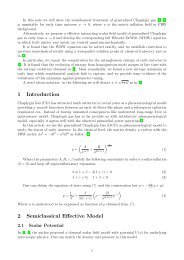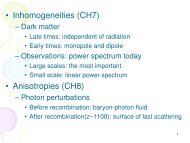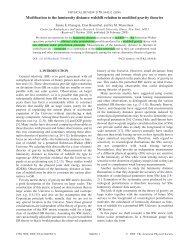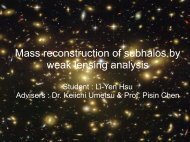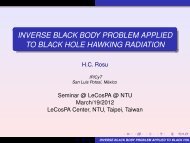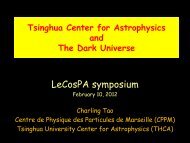Extended gravity theories and the Einstein--Hilbert action
Extended gravity theories and the Einstein--Hilbert action
Extended gravity theories and the Einstein--Hilbert action
You also want an ePaper? Increase the reach of your titles
YUMPU automatically turns print PDFs into web optimized ePapers that Google loves.
<strong>Extended</strong> graviry <strong><strong>the</strong>ories</strong> 27 1<br />
where 4 (1 + k'p)/G~ <strong>and</strong> m2 f (4) = LY~*/G~ = (GD@ - 1)*/(4aG~). O'Hanlon<br />
introduced his <strong>action</strong> to produce a 'fifth force' Yukawa type inter<strong>action</strong> in <strong>the</strong> quasi-<br />
Newtonian gravitational potential, so it is not surprising that it also appears in <strong>the</strong> weak-field<br />
limit of fourth-order <strong>gravity</strong> [15].<br />
This equivalence applies to any gravitational Lagrangian that is a function of <strong>the</strong> Ricci<br />
scalar.<br />
where ' denotes differentiation with respect to 9. The field equation for 'p again gives 9 = R,<br />
provided F" # 0, which substituted into <strong>the</strong> metric field equations gives <strong>the</strong> st<strong>and</strong>ard field<br />
equations for <strong>the</strong> F(R) Lagrangian.<br />
In O'Hanlon's notation, we have<br />
Go@ F'('p) Gom2 f (4) = 'pF' - F. (9)<br />
3. Higher-order <strong>gravity</strong> as scalar-tensor <strong>gravity</strong><br />
We can extend this equivalence to sixth- or arbitrarily high-order <strong>gravity</strong> <strong><strong>the</strong>ories</strong> derived<br />
from Lagrangians that are functions not only of R but also OR or O"R, where U is<br />
<strong>the</strong> d'Alembertian. Such terms can also be generated by quantum corrections to general<br />
relativity <strong>and</strong> <strong>the</strong>se <strong><strong>the</strong>ories</strong> have recently been studied in <strong>the</strong> context of inflationary<br />
cosmology [16,17].<br />
Notice that apparently different Lagrangians F(O'R) can yield identical field equations<br />
if <strong>the</strong>y differ only by a total divergence, as this can be written as a boundary term which<br />
cannot contribute to <strong>the</strong> Euler-Lagrange equations. For instance, OiR alone is a total<br />
divergence <strong>and</strong> can be ignored, while a term O"ROmR can be integrated by parts to give<br />
RGmt"R. Thus I can take any polynomial function F(0'R) to be linear in its highest-order<br />
derivative (O"R), <strong>and</strong> that this ierm is multiplied only by a function of <strong>the</strong> Ricci scalar,<br />
F,(R). Its field equations contain (2n + 4)-order derivatives of <strong>the</strong> metric tensor. Any<br />
Lagrangian containing a term 0"R multiplied by derivatives of <strong>the</strong> Ricci scalar, or any<br />
o<strong>the</strong>r fields, corresponds to a still higher-order <strong>gravity</strong> <strong>the</strong>ory as it can be integmted by<br />
p m to give terms at least of order U""+' R.<br />
Consider <strong>the</strong>n <strong>the</strong> <strong>action</strong> for (2n + 4)-order <strong>gravity</strong>, with a polynomial F(O'R) =<br />
Fo(0'"" R) + F, (R)O"R<br />
The classical field equations are [I61<br />
I<br />
= ~XGDT'" + -g""(F - OR) + (g"gvK - g""g")O;~,<br />
2


